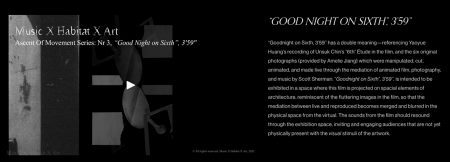Manifest Gallery’s current exhibition The Five Themes Project is an expansive undertaking; not unlike re-inventing the Whole Earth Catalog. This time, however, it’s not about self-sufficiency and ecology but perceptions about the world and mankind’s relationship with it. The five themes – Wilderness→ Rural→ Suburban→ Urban→ Post-Urban – are installed as a somewhat chronological survey of mankind’s interaction with the environment. Considering space, demographics and habitat over time, our relationship to nature/the environment, and one another has become more intricate,
multi-faceted and inevitably problematic.
As you might expect, there’s a range of imagery, mediums, and attitude. The diversity and quality of the work achieves the usual standards Manifest demands. There are drawings, prints, sculpture, mixed media, paintings, found objects, and state-of-the-art digital work. While the works exist in 3D space, add the 4th dimension to digest it all and possibly the fifth will take you places you’ve never gone to before.
In forest wanderings
Wreathed in green &
kissed by the
dappled light
breaking thru high
canopy, I am lost
in pondering.
Foremost on my mindare
the trappings
of Man “unnatural”
is the bear trap
any less natural
than the bear?
Metaphorically, man was inside Nature’s box, but over time we’ve moved outside.
Beginning with Wilderness, as we might expect, Nature has the upper hand. Karen Rumora’s Adrift , encaustic and handmade paper, presents us with a pooling array of land masses or algae. Is it a map for the beginning or the denouement in waterworld? The glacier’s craggy edges meeting the sea in Tonia Hughes’ Ending portend an advance toward this demise. Meanwhile, other images suggest Nature’s increasing hostility to our situation. Elizabeth Weber’s Home is a gargantuan wasp’s nest situated in a high corner of the gallery while her Colony is neatly ensconced on a bed of honey locust thorns. The elegance of these natural forms belie a reminder that we are outnumbered by the insect world and collectively fragile. Finally, I can’t resist mentioning Aly Ogasian & Claudia O’Steen’s giclée print, Keeweenaw Observing Station (19 Jul 8:33 PM) for its strange likeness to a shipwreck.
Will our observations of nature be troubling?
Rural as we know it in America, is losing population with family farms disappearing and small towns boarding up. As a group, the artists represented unanimity in the portrayal of the countryside as desolate, run down, and isolated. Even the titles offered no reprise from the abandonment of rural America: to list a few: Rural Divide, Transplantations I & II, At the Limit II, Derelict Home, Evidences of an Excavation and Bituminous Settlements II. Visually, Jason Lanegan’s At the Limit II distilled this feeling of loss and isolation without hope by placing a 19th century wood church on the edge of the Bonneville Salt Flats. Its bleak austerity coupled with the monumental scale differences reminded me of Kenneth Clark’s quoting de Sade on William Turner’s poem The Fallacies of Hope, “Nature is indifferent.”
Stepping in to more familiar territory, Suburban touches upon the humor, banality, repetition, and synthetic assimilation of lifestyle. Roscoe Wilson’s Front Yard Zoo: Two Bunnies utilizes actual materials frequently substituted for natural ones. Two plastic bunnies, lawn tchotchke, if you will, crouch near a concrete foundation resting upon astro-turf. The bare pine buttress implies a house or sanctuary as well as stabilizing the concrete block. Small rodents, foxes, and deer abound in suburbia yet people are often drawn to lawn ornaments that hail a former era/place i.e. wilderness or rural land.
In forsaking the rural landscape for suburban life, the cookie cutter approach to housing is ubiquitous. James Wade’s Buttercup and Gumball transform protective styrofoam product packaging into cast aluminum which then contain replicated suburban homes. Buttercup is a cloying yellow package with four pockets where each contains a classic 20th century home. The overall effect is only missing the blister wrap. Gumball is more like a positive-negative die cut object that also intimates mass production and repetition. The banal titles affirm their anonymous origin and eventual uniform application.
The rigorous geometry in Chris Bergeron’s Sitting Inside – Pool Side is matched by the perfection of Chris Offutt’s Taylor, Mississippi and Maddie Aunger’s Off-White Window and in each the proverbial box dictates conformity, isolation, and sterility. Only when we go inside the box as in Stephen Yuen’s Koko Head Living Room or Kareem Obey’s Night Apartment 2 do we begin to experience a more animate world. Here, a bit of randomness, texture, light and color relieve the arduous control outside. Perhaps it’s a fitting segue to the Urban theme, that we find Shannon Pritchard’s Contents May be Flammable installed by the door. With so much control and uniformity entering our lives, perhaps we, the contents of these habitat boxes, are the combustibles.
Have we hit the wall, like Miranda Brandon’s Impenetrable? Are we forever building a better box å la John Ferry’s Detroit #4. Is man’s nature a perpetual deconstruction of our own making? Dereck Mangus, Marlene Steele and Lydia Thompson concur that our nature is destined to do just that.
Finally, the video collaboration Good Night on Sixth (https://www.yaoyuehuang.com/musicxhabitatxart) by MusicXHabitatXArt (Scott Lowell Sherman, Amelie Jiang, and Yaoyue Huang) melds organic patterns of Nature, man-made materials, abstract instances of light and darkness with arhythmic intervals of solo piano that evokes a symbiotic dance. Here it seems, dimensions of time and space coalesce to suggest a more integrated relationship.
The matter of symbiosis between man and Nature is challenged in the Post-Urban theme and adeptly so in Bob Mosler’s Chaos. Its notion of strangeness and fabrication, free motion thread painting, invokes mutation, stringed matter and harkens back in odd ways to Karen Rumora’s Drift in Wilderness. Here, the floating matter has coalesced into something new but alien. Like Mosler, other artworks pose questions regarding transformation, mutation, and randomness. These and other questions inhabit the 5th theme, Post -Urban. For answers, you’d have to be there.
(insert image 8)
–Cole Carothers







